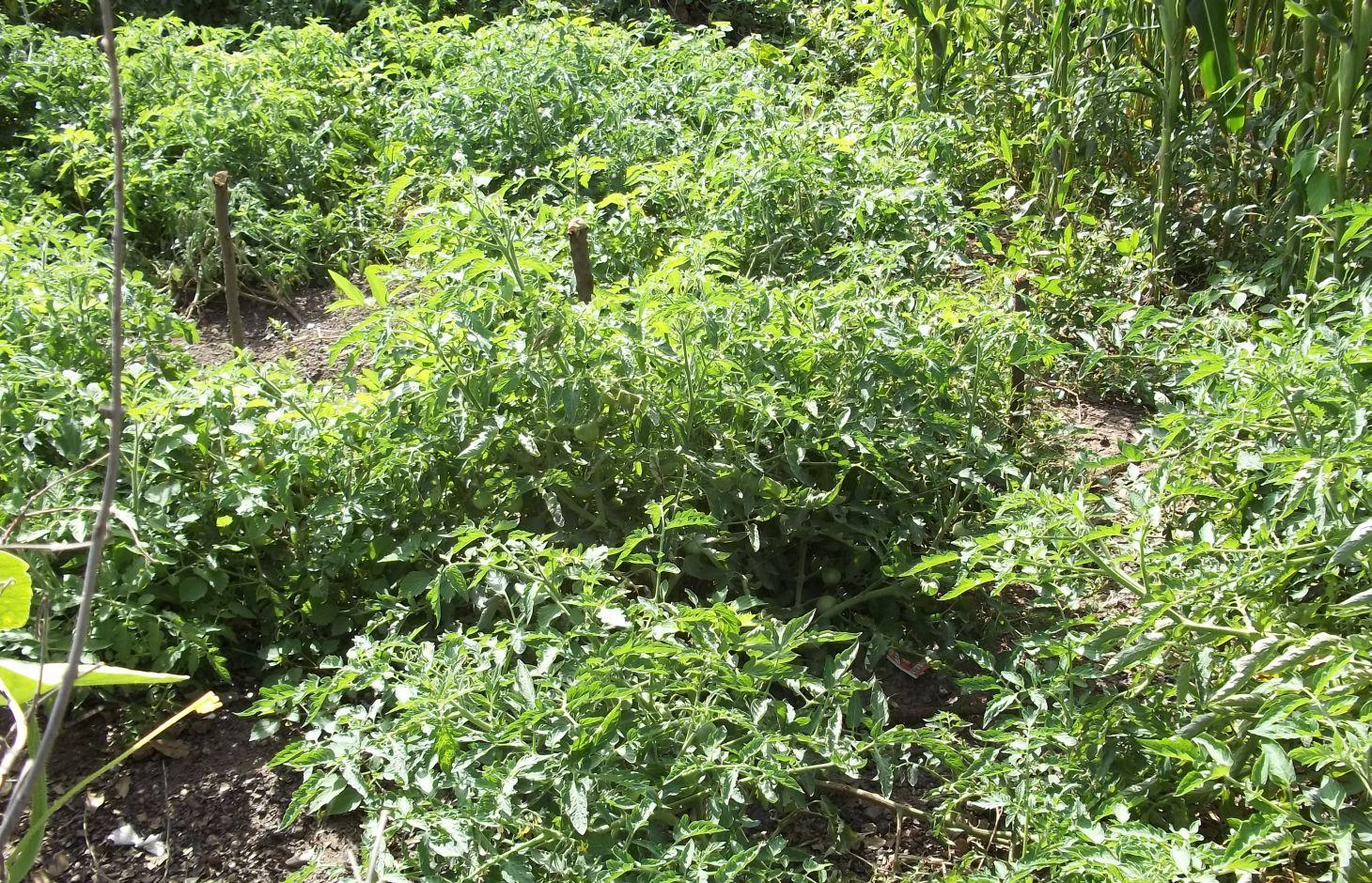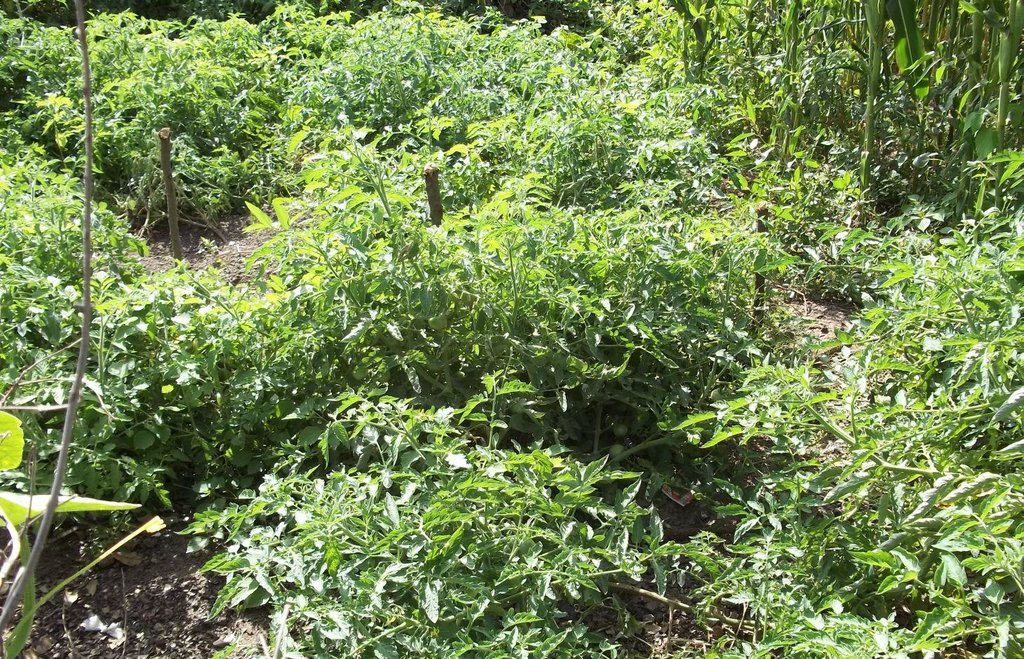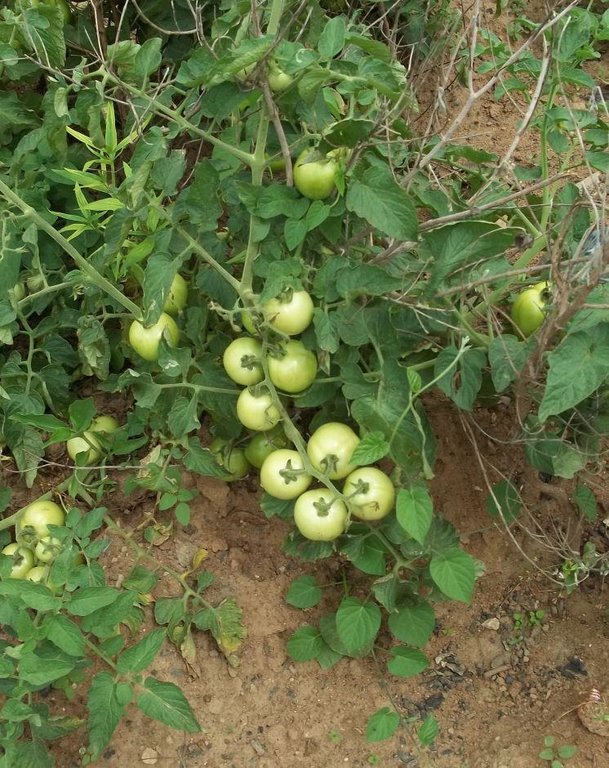Introducing tomato varieties using succession planting [Mali]
- Creation:
- Update:
- Compiler: Dieter Nill
- Editor: –
- Reviewers: Deborah Niggli, Alexandra Gavilano
Introduction des variétés de tomates d’un cycle cultural échelonné (French)
technologies_1636 - Mali
View sections
Expand all Collapse all1. General information
1.2 Contact details of resource persons and institutions involved in the assessment and documentation of the Technology
SLM specialist:
Dako Jean Parfait
National Directorate of Agriculture
Mali
Name of project which facilitated the documentation/ evaluation of the Technology (if relevant)
Manual of Good Practices in Small Scale Irrigation in the Sahel (GIZ )Name of the institution(s) which facilitated the documentation/ evaluation of the Technology (if relevant)
Deutsche Gesellschaft für Internationale Zusammenarbeit (GIZ) GmbH (GIZ) - Germany1.3 Conditions regarding the use of data documented through WOCAT
The compiler and key resource person(s) accept the conditions regarding the use of data documented through WOCAT:
Ja
1.4 Declaration on sustainability of the described Technology
Is the Technology described here problematic with regard to land degradation, so that it cannot be declared a sustainable land management technology?
Nee
2. Description of the SLM Technology
2.1 Short description of the Technology
Definition of the Technology:
Increasing the revenues of growers through the production of off-season tomatoes
2.2 Detailed description of the Technology
Description:
Tomato production in the off-season is restricted by the prevalence of insects and disease at that time. To mitigate these difficulties, it is important to find sustainable, non-polluting solutions that are accessible to producers. These solutions are: good tomato growing practices, the use of resilient and suitable tomato varieties, and biological control. Some varieties of off-season tomatoes have produced well and shown a certain resilience to diseases and other pests (nematodes and aphids). Growing tomatoes off season also means the market can be supplied when such produce is lacking.
The specific objectives of growing off-season tomatoes are: promoting market garden production during the off-season; reducing the scarcity of tomatoes in the off-season; increasing the revenues of growers. The average yield obtained from each crop is around 15,500 kilograms per ha, with yields peaking at 35,500 kilograms per ha in some places.
Implementation: 1) Select a site for the nursery that is near to a water source. Clean and turn the soil in the plot. The insects and weeds in the soil often pass on disease to young nursery plants. It is therefore necessary to disinfect the soil. Manure must be worked into the soil or compost prior to disinfection. In the week prior to treatment, the nursery soil must be kept sufficiently moist. Growers can disinfect their soil with fire, hot water, or chemical products. 2) The way a bed is prepared depends on the season. In the dry season, the nursery bed is sunk into the ground so that it holds water better. In the rainy season, the nursery bed is raised (mounded) to prevent waterlogging and promote good drainage once the rains have abated. 3) Seed requirement: Two to three grams for each 100-square-metre plot. Fresh market tomatoes: 300 grams per hectare. Industrial tomatoes: 400 grams per hectare. 4) Fertilisers are optional. During sowing, they can be applied in small quantities in soluble form. Alternatively, three kg of well-rotted manure can be applied per square metre. 5) Protecting plants: Combat leafminers and prevent damping off by applying authorised plant health products. Cover the nursery with a mosquito net until the seedlings are planted out. 6) Seedbeds are laid out in rows 15 to 20 centimetres apart. The seeds are sown along one-centimetre-deep furrows or simply scattered. Seed density should be 100 per linear metre, i.e. 500 per square metre. The seeds are then covered with earth or fine sand. The beds are covered with straw, which is removed as soon as the seedlings sprout. Duration of nursery stage: three to four weeks. 7) Healthy and strong plants with at least six proper leaves are planted out. The distance required between plants varies according to the season, growing conditions and varieties in question: 80 x 60 cm; 80 x 40 cm; 60 x 60 cm; 60 x 40 cm. When transplanting plants, compact the earth around the roots. Each plant must be carefully extracted along with the clump of earth its roots are embedded in. Dig a hole in the bed and insert the plant. Plants are planted in raised beds or mounds in the rainy season and in the beds or flat ploughed ground outside of the rainy season. Transplanting should be carried out at the end of the day, when it is cooler. Water plants immediately after planting them out. Whatever the growing season, it is best to cover young, freshly transplanted plants with a straw cover providing adequate shade. If some plants die, replace them with others held in the nursery. 8) How to prune tomato plants: Remove buds growing between the leaf and the stalk. Retain only one or two thick stalks with their leaves and their flowers. Pruning should be carried out once or twice a month. Prune tomato plants whose fruit will be used for industrial purposes or canned (determinate tomatoes may not be pruned). From time to time, remove suckers (a side shoot from an axillary bud) when weeding and hoeing. For fast-growing varieties, retain just one thick stalk. 9) The quantities of chemical fertiliser to apply vary as follows: 40 to 120 kilograms of nitrogen per ha, 30 to 90 kilograms of phosphate per ha, and 30 to 90 kilograms of potash per ha. Never spray fertilisers on young or wet plants as this will burn them. An alternative is 20 to 30 tonnes of organic fertiliser per ha 10) Plant care: Plants must be watered regularly (morning and evening), particularly during fruit formation. The water quantities are then reduced towards the end of the growing cycle. Weed and hoe regularly, especially in the early stages of planting. Stake the tomato cultivars before they begin forming fruit. This will stop the fruits touching the ground. Using mulch provides better quality fruit.
2.3 Photos of the Technology
2.5 Country/ region/ locations where the Technology has been applied and which are covered by this assessment
Country:
Mali
Region/ State/ Province:
Mali
Further specification of location:
Kayes, Koulikoro, Sikasso, Ségou, Mopti, Bamako
Specify the spread of the Technology:
- evenly spread over an area
If the Technology is evenly spread over an area, specify area covered (in km2):
0.75
Comments:
Total area covered by the SLM Technology is 0.75 km2.
The succession planting programme for the 2010/11 and 2011/12 growing seasons covered a total of 40 circles in six regions (Kayes, Koulikoro, Sikasso, Ségou and Mopti and Bamako District). Farming advisors cascaded training to 1,200 producers who own succession-planted plots. Each succession plot is 400 square metres in size. In total, 75 hectares have been sown by producers.
2.6 Date of implementation
If precise year is not known, indicate approximate date:
- less than 10 years ago (recently)
2.7 Introduction of the Technology
Specify how the Technology was introduced:
- through projects/ external interventions
Comments (type of project, etc.):
Ongoing for three years
3. Classification of the SLM Technology
3.1 Main purpose(s) of the Technology
- improve production
3.2 Current land use type(s) where the Technology is applied

Cropland
- Annual cropping
Number of growing seasons per year:
- 1
Specify:
Longest growing period in days: 120; Longest growing period from month to month: August-November
Comments:
Major land use problems (compiler’s opinion): Tomato production in the off-season is restricted by the prevalence of insects and disease at that time, scarcity of tomatoes in the off-season
3.4 Water supply
Water supply for the land on which the Technology is applied:
- mixed rainfed-irrigated
3.5 SLM group to which the Technology belongs
- integrated pest and disease management (incl. organic agriculture)
3.6 SLM measures comprising the Technology

vegetative measures
- V1: Tree and shrub cover
Comments:
Type of vegetative measures: scattered / dispersed
3.7 Main types of land degradation addressed by the Technology

biological degradation
- Bp: increase of pests/ diseases, loss of predators
Comments:
Main causes of degradation: other natural causes (avalanches, volcanic eruptions, mud flows, highly susceptible natural resources, extreme topography, etc.) specify (insects and diseases)
3.8 Prevention, reduction, or restoration of land degradation
Specify the goal of the Technology with regard to land degradation:
- reduce land degradation
4. Technical specifications, implementation activities, inputs, and costs
4.1 Technical drawing of the Technology
Technical specifications (related to technical drawing):
Raised bed (15 to 20 centimetres high). In the rainy season, the nursery bed is raised (mounded) to prevent waterlogging and promote good drainage once the rains have abated. In the dry season, the nursery bed is sunk into the ground so that it holds water better.
Technical knowledge required for field staff / advisors: high
Technical knowledge required for land users: low
Main technical functions: promotion of vegetation species and varieties (quality, eg palatable fodder), use of resilient and suitable tomato varieties
Scattered / dispersed
Vegetative material: F : fruit trees / shrubs
Author:
DNA
4.3 Establishment activities
| Activity | Timing (season) | |
|---|---|---|
| 1. | Select a site for the nursery that is near to a water source | |
| 2. | disinfect the soil | |
| 3. | sowing of seeds | |
| 4. | Fertilisers are optional. During sowing, they can be applied in small quantities in soluble form | |
| 5. | Cover the nursery with a mosquito net until the seedlings are planted out |
4.5 Maintenance/ recurrent activities
| Activity | Timing/ frequency | |
|---|---|---|
| 1. | Healthy and strong plants with at least six proper leaves are planted out | |
| 2. | When transplanting plants, compact the earth around the roots. Each plant must be carefully extracted along with the clump of earth its roots are embedded in | |
| 3. | Dig a hole in the bed and insert the plant. | |
| 4. | Water plants immediately after planting them out | |
| 5. | cover young, freshly transplanted plants with a straw cover providing adequate shade. | |
| 6. | If some plants die, replace them with others held in the nursery | |
| 7. | prune tomato plants | |
| 8. | Plants must be watered regularly (morning and evening), particularly during fruit formation. | |
| 9. | Weed and hoe regularly, especially in the early stages of planting. Stake the tomato cultivars before they begin forming fruit |
4.7 Most important factors affecting the costs
Describe the most determinate factors affecting the costs:
Economic analysis of off-season tomato production from 2012 to 2013:
Total area sown with off-season tomato: 175 hectares
Quantity of off-season tomatoes grown: 4,300 tonnes
Price of tomatoes grown in season: 170 to 200 CFA francs per kilogram
Price of tomatoes grown off season: 600 to 800 CFA francs per kilogram
Each grower produces an average 650 kilograms on a succession plot, with some producing up to 1,400 kilograms. Produce from the plots has earned growers between 300,000 and 630,000 CFA francs (gross) over the winter season, with 75% of production sold at 600 CFA francs per kilogram.
5. Natural and human environment
5.1 Climate
Annual rainfall
- < 250 mm
- 251-500 mm
- 501-750 mm
- 751-1,000 mm
- 1,001-1,500 mm
- 1,501-2,000 mm
- 2,001-3,000 mm
- 3,001-4,000 mm
- > 4,000 mm
Agro-climatic zone
- semi-arid
Thermal climate class: tropics
5.2 Topography
Slopes on average:
- flat (0-2%)
- gentle (3-5%)
- moderate (6-10%)
- rolling (11-15%)
- hilly (16-30%)
- steep (31-60%)
- very steep (>60%)
Landforms:
- plateau/plains
- ridges
- mountain slopes
- hill slopes
- footslopes
- valley floors
Altitudinal zone:
- 0-100 m a.s.l.
- 101-500 m a.s.l.
- 501-1,000 m a.s.l.
- 1,001-1,500 m a.s.l.
- 1,501-2,000 m a.s.l.
- 2,001-2,500 m a.s.l.
- 2,501-3,000 m a.s.l.
- 3,001-4,000 m a.s.l.
- > 4,000 m a.s.l.
5.3 Soils
Soil depth on average:
- very shallow (0-20 cm)
- shallow (21-50 cm)
- moderately deep (51-80 cm)
- deep (81-120 cm)
- very deep (> 120 cm)
Soil texture (topsoil):
- medium (loamy, silty)
- fine/ heavy (clay)
Topsoil organic matter:
- medium (1-3%)
- low (<1%)
5.4 Water availability and quality
Ground water table:
5-50 m
Availability of surface water:
medium
Water quality (untreated):
for agricultural use only (irrigation)
5.5 Biodiversity
Species diversity:
- medium
5.6 Characteristics of land users applying the Technology
Market orientation of production system:
- mixed (subsistence/ commercial)
Off-farm income:
- 10-50% of all income
Relative level of wealth:
- poor
- average
Level of mechanization:
- manual work
Gender:
- men
Indicate other relevant characteristics of the land users:
Population density: < 10 persons/km2
Annual population growth: 2% - 3%
10% of the land users are rich.
50% of the land users are average wealthy.
30% of the land users are poor.
10% of the land users are very poor.
5.7 Average area of land used by land users applying the Technology
- < 0.5 ha
- 0.5-1 ha
- 1-2 ha
- 2-5 ha
- 5-15 ha
- 15-50 ha
- 50-100 ha
- 100-500 ha
- 500-1,000 ha
- 1,000-10,000 ha
- > 10,000 ha
Is this considered small-, medium- or large-scale (referring to local context)?
- small-scale
5.8 Land ownership, land use rights, and water use rights
Comments:
The irrigated land is allocated by the chief
5.9 Access to services and infrastructure
health:
- poor
- moderate
- good
education:
- poor
- moderate
- good
technical assistance:
- poor
- moderate
- good
employment (e.g. off-farm):
- poor
- moderate
- good
markets:
- poor
- moderate
- good
energy:
- poor
- moderate
- good
roads and transport:
- poor
- moderate
- good
drinking water and sanitation:
- poor
- moderate
- good
financial services:
- poor
- moderate
- good
6. Impacts and concluding statements
6.1 On-site impacts the Technology has shown
Socio-economic impacts
Income and costs
farm income
Socio-cultural impacts
food security/ self-sufficiency
conflict mitigation
contribution to human well-being
Comments/ specify:
Some varieties of off-season tomatoes have produced well and shown a certain resilience to diseases and other pests (nematodes and aphids). Growing tomatoes off season also means the market can be supplied when such produce is lacking. The average yield obtained from each crop is around 15,500 kilograms per ha, with yields peaking at 35,500 kilograms per ha in some places.
Ecological impacts
Soil
soil cover
Biodiversity: vegetation, animals
biomass/ above ground C
plant diversity
pest/ disease control
6.3 Exposure and sensitivity of the Technology to gradual climate change and climate-related extremes/ disasters (as perceived by land users)
Gradual climate change
Gradual climate change
| Season | increase or decrease | How does the Technology cope with it? | |
|---|---|---|---|
| annual temperature | increase | well |
Climate-related extremes (disasters)
Meteorological disasters
| How does the Technology cope with it? | |
|---|---|
| local rainstorm | well |
| local windstorm | well |
Climatological disasters
| How does the Technology cope with it? | |
|---|---|
| drought | well |
Hydrological disasters
| How does the Technology cope with it? | |
|---|---|
| general (river) flood | well |
Other climate-related consequences
Other climate-related consequences
| How does the Technology cope with it? | |
|---|---|
| reduced growing period | well |
6.4 Cost-benefit analysis
How do the benefits compare with the establishment costs (from land users’ perspective)?
Short-term returns:
very positive
Long-term returns:
very positive
How do the benefits compare with the maintenance/ recurrent costs (from land users' perspective)?
Short-term returns:
very positive
Long-term returns:
very positive
6.7 Strengths/ advantages/ opportunities of the Technology
| Strengths/ advantages/ opportunities in the compiler’s or other key resource person’s view |
|---|
| some varieties of off-season tomatoes have produced well and shown a certain resilience to diseases and other pests (nematodes and aphids). |
| reduction of the scarcity of tomatoes in the off-season |
| Growing tomatoes off season also means the market can be supplied when such produce is lacking |
| The possibility of selling tomatoes during the winter season is very useful for restarting and increasing production. Growers are very enthusiastic about the technology. |
6.8 Weaknesses/ disadvantages/ risks of the Technology and ways of overcoming them
| Weaknesses/ disadvantages/ risks in the compiler’s or other key resource person’s view | How can they be overcome? |
|---|---|
| availability of inputs and farming advisors for carrying out the practice |
7. References and links
7.1 Methods/ sources of information
- field visits, field surveys
- interviews with land users
When were the data compiled (in the field)?
01/07/2012
7.2 References to available publications
Title, author, year, ISBN:
Manual of Good Practices in Small Scale Irrigation in the Sahel. Experiences from Mali. Published by GIZ in 2014.
Available from where? Costs?
http://star-www.giz.de/starweb/giz/pub/servlet.starweb
Title, author, year, ISBN:
DNA (2012): Data sheet on growing off-season tomatoes
Title, author, year, ISBN:
DNA (2013): Detailed report, West Africa Agricultural Productivity Program (WAAPP)
Links and modules
Expand all Collapse allLinks
No links
Modules
No modules





